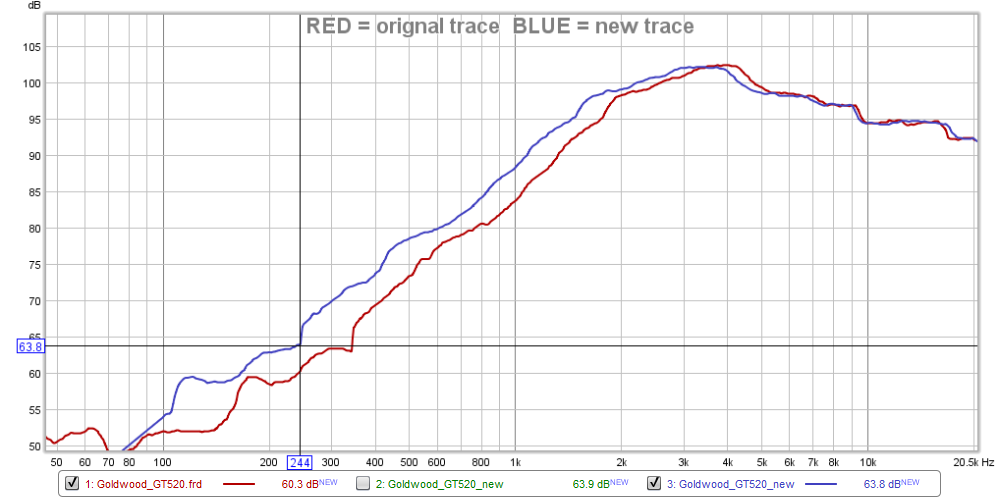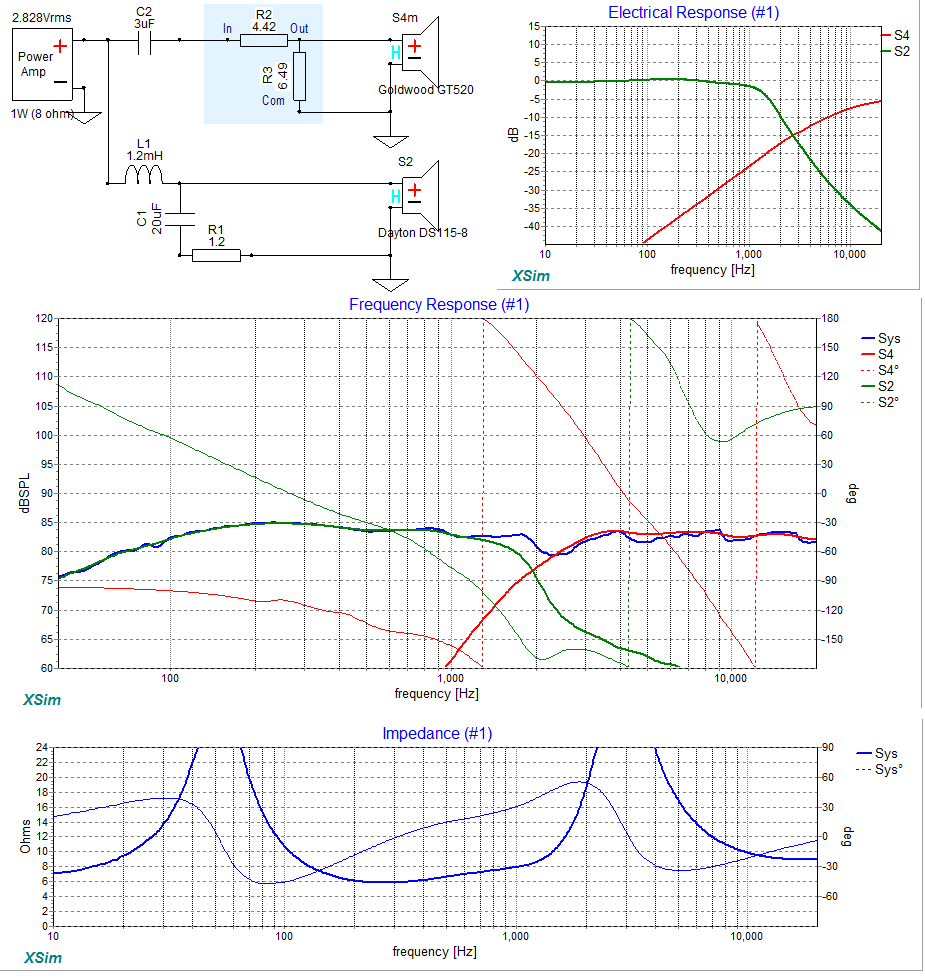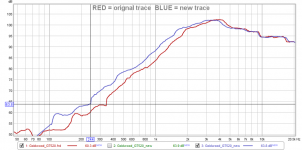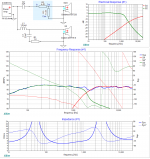Hello Everyone,
I've been really enjoying learning the basics of speaker design and building my own speakers. I first built a set of big 1.65 ft^3 ported two way speakers for my apartment using a Dayton RS255-8 Woofer and Dayton DC28FS-8 Tweeter. I learned a lot about design and construction from this product, but didn't feel capable of designing my own crossover at the time.
Fast forward a year or so to now and I'm interested in making my own crossover design. I wrote up the parts and my design process in the attached PDF file, if any of you have the time to read though it and give me some feedback it would be greatly appreciated.
PDF File attached (but is very large), or Linked here
If anyone really hates the format I could transcribe it here into forums format, but I wanted to use Markdown and Latex, hence the PDF .
I've been really enjoying learning the basics of speaker design and building my own speakers. I first built a set of big 1.65 ft^3 ported two way speakers for my apartment using a Dayton RS255-8 Woofer and Dayton DC28FS-8 Tweeter. I learned a lot about design and construction from this product, but didn't feel capable of designing my own crossover at the time.
Fast forward a year or so to now and I'm interested in making my own crossover design. I wrote up the parts and my design process in the attached PDF file, if any of you have the time to read though it and give me some feedback it would be greatly appreciated.
PDF File attached (but is very large), or Linked here
If anyone really hates the format I could transcribe it here into forums format, but I wanted to use Markdown and Latex, hence the PDF .
Hi Sjrand
Welcome.
Can you zip up your XSim file and post it?
Also, I'm sure I missed it, did you measure the FR and ZMA yourself?
Best,
E
Hi Erik,
Thanks so much for the help! Folder with XSim, and fr and zma files here: Simulation - Google Drive
I didn't measure them myself, I'm using the Dayton files for the woofer, and SPL trace over the provided graphs for the tweeter. I recognize that this is less ideal than taking true measurements in the enclosure and space, but I only have a fairly basic little measurement microphone from dayton and no good place to measure well. I'm hoping that the fairly simple and flat sealed enclosure should help reduce the need for the box FRD adjustments. I used to have to WinISD file for the box with the driver and enclosure, but I seem to be having trouble finding it, although I can definitely work on that if it would help you.
Sorry about your sickness, that's never fun.
--Spencer
You need to account for the baffle step and cabinet somehow. Either by measuring, using Bagby's tools, or merging a baffle step simulation with the FR.
I think there's a pinned thread on speaker design without measurement, but I never recommend that approach. I strongly recommend you measure your drivers in place using OmniMic, Room EQ Wizard or other tools.
I strongly recommend you measure your drivers in place using OmniMic, Room EQ Wizard or other tools.
Best,
E
I think there's a pinned thread on speaker design without measurement, but I never recommend that approach.
Best,
E
Hi Spencer,
You're to be commended on preparing your ( very thorough ) back-grounding document .
I'm confident that you can expect some quality help will come your way ( sooner than later ).

Thanks so much for the kind words Earl. I was hesitant to make all the content be in an attachment, but it gave me much more capability to include more information and format it better.
I'm a college senior studying mechanical engineering, but all these wires and electrical bits have got me running in circles, so I look forward to learning lots and improving the design.
Regards,
Spencer
You need to account for the baffle step and cabinet somehow. Either by measuring, using Bagby's tools, or merging a baffle step simulation with the FR.
I think there's a pinned thread on speaker design without measurement, but I never recommend that approach.I strongly recommend you measure your drivers in place using OmniMic, Room EQ Wizard or other tools.
Best,
E
Hi Erik,
Indeed the thread on speaker design without measurement was the basis for this whole design, and all the calculations I used in the document. I think the $300 OmniMic is a bit out of my college student budget right now, but I did purchase the inexpensive Dayton MM6 (Dayton Audio iMM-6 Calibrated Measurement Microphone for Tablets iPhone iPad and Android), and I could potentially do measurements of the speakers in the room they sit in for both the tweeter and the woofer. The room is definitely not optimal for measuring, but I could take a few positions and do some type of averaging potentially? What would be your recommended course of action. I could definitely also work on one of the software approaches, give me some guidance and I'll get on it.
I'm about to board a plane (in 15 minutes) back home, so measurements might wait a couple days but could definitely be done, so let me know!
Thanks,
Spencer
Hi SJ,
Since you are only doing a 2-way, you can cheat. Just use gated FR measurements using Room EQ Wizard, and try to get the window well below the crossover f.
Just use gated FR measurements using Room EQ Wizard, and try to get the window well below the crossover f.
There's also online discussions about how to use REW to measure driver Z. You should do this for the woofer in the cabinet.
You need gated FR, Z and also acoustic offsets. If you can get those three, that's all you need. You don't need to do room averaging for crossover design so much.
Best,
E
Since you are only doing a 2-way, you can cheat.
There's also online discussions about how to use REW to measure driver Z. You should do this for the woofer in the cabinet.
You need gated FR, Z and also acoustic offsets. If you can get those three, that's all you need. You don't need to do room averaging for crossover design so much.
Best,
E
Hi SJ,
Since you are only doing a 2-way, you can cheat.Just use gated FR measurements using Room EQ Wizard, and try to get the window well below the crossover f.
There's also online discussions about how to use REW to measure driver Z. You should do this for the woofer in the cabinet.
You need gated FR, Z and also acoustic offsets. If you can get those three, that's all you need. You don't need to do room averaging for crossover design so much.
Best,
E
Hi Erik,
Okay, that seems a bit more manageable, although I'm a little bummed to have to go buy a $100 measurement microphone, but I suppose it's a useful investment for the future. I'll read up on REW. I'm assuming I need those 3 measurements in addition to the baffle step stuff?
Not to seem exasperated but I'm wondering how truly noticable the difference would likely be between a "no measurements design" such as the current one, and one that was refined with baffle step, room eq, and full measuring. I'm not trying to avoid doing it, just need motivation/reassurance that for casual listening with only moderate source quality I'll notice an appreciable difference.
Regards,
S
Spencer,
Since you had such a nice presentation here's some help;
To start off I redid your trace of the Goldwood tweeter ( I thought it looked a bit off or shifted ).
A word of caution is in order, "Don't Blindly Trust Tracing Programs" ( I've had to learn this same lesson the hard-way myself )
Identify some unique feature in the original trace and make sure the traced file has the same unique feature ( in the same frequency area ) .
Here's a comparison of your old vs my new :

In the case of your speaker these tracing errors happen to matter quite a lot ( since the LF tweeter roll-off happens earlier in your trace ) and you need all the LF performance we can get from this tweeter ( since usable woofer response dies after 2K ).
I've included 6 different approaches ( 6 XSim files in a folder ) aimed at making a network that can stitch together these two drivers ( that were IMHO never meant to go together ).
- I've arbitrarily set the acoustic center of the tweeter 1/2" back from the woofer ( this is just a guess and it really needs to be acoustically measured to get that figure to be correct ) .
#4 will likely be your best overall budget crossover ( with a live-able hole between 2-3K ) while #6 fills that hole ( at the expense of added network cost and a loss of some efficiency ).
- You can play with moving the tweeters acoustic center to other distances to see how they effect the overall response at crossover .
Here's V4 ( the shaded blue area represents an 8-ohm variable LPad) which is an affordable network.

As I said, I was impressed with your presentation paper ( that's the only reason I decided to get involved here ).
You get top marks for presentation but only passing marks on execution.
As Eric has noted, you need to have actual measuring capability to take this to the next ( proper ) level .
I suppose one of those little Dayton imm-6 mics will be good enough to get you going ( with a 1/3 octave RTA program for your phone ).
One needs to be aware though of some of its limitations .
For example, Pink Noise ( about the only test signal available to a phone ) usually has a 3-6db crest factor that makes the sound being measured jump around by that same amount, in db.
- That means the 2-3K hole can easily get obscured ( momentarily ) depending on when you look at ( or capture ) the screen output .
Good Luck with your studies!

Since you had such a nice presentation here's some help;
To start off I redid your trace of the Goldwood tweeter ( I thought it looked a bit off or shifted ).
A word of caution is in order, "Don't Blindly Trust Tracing Programs" ( I've had to learn this same lesson the hard-way myself )
Identify some unique feature in the original trace and make sure the traced file has the same unique feature ( in the same frequency area ) .
Here's a comparison of your old vs my new :
In the case of your speaker these tracing errors happen to matter quite a lot ( since the LF tweeter roll-off happens earlier in your trace ) and you need all the LF performance we can get from this tweeter ( since usable woofer response dies after 2K ).
I've included 6 different approaches ( 6 XSim files in a folder ) aimed at making a network that can stitch together these two drivers ( that were IMHO never meant to go together ).
- I've arbitrarily set the acoustic center of the tweeter 1/2" back from the woofer ( this is just a guess and it really needs to be acoustically measured to get that figure to be correct ) .
#4 will likely be your best overall budget crossover ( with a live-able hole between 2-3K ) while #6 fills that hole ( at the expense of added network cost and a loss of some efficiency ).
- You can play with moving the tweeters acoustic center to other distances to see how they effect the overall response at crossover .
Here's V4 ( the shaded blue area represents an 8-ohm variable LPad) which is an affordable network.
As I said, I was impressed with your presentation paper ( that's the only reason I decided to get involved here ).
You get top marks for presentation but only passing marks on execution.
As Eric has noted, you need to have actual measuring capability to take this to the next ( proper ) level .
I suppose one of those little Dayton imm-6 mics will be good enough to get you going ( with a 1/3 octave RTA program for your phone ).
One needs to be aware though of some of its limitations .
For example, Pink Noise ( about the only test signal available to a phone ) usually has a 3-6db crest factor that makes the sound being measured jump around by that same amount, in db.
- That means the 2-3K hole can easily get obscured ( momentarily ) depending on when you look at ( or capture ) the screen output .
Good Luck with your studies!
Attachments
Last edited:
Oh ( btw ),
I shaved off 5db ( within the driver spec. in XSim ) since I don't believe the Goldwood tweeter is anywhere near their stated efficiency .
That's one reason why I included a variable Lpad ( in a few of the network designs ).
I figure HF balance is one area that will need a lot of user adjustment.

I shaved off 5db ( within the driver spec. in XSim ) since I don't believe the Goldwood tweeter is anywhere near their stated efficiency .
That's one reason why I included a variable Lpad ( in a few of the network designs ).
I figure HF balance is one area that will need a lot of user adjustment.
You can use the Dayton imm6 with Room EQ Wizard by the way, just need to get the adapters. 
That should be around $30. However, a stand is needed, but any camera tripod will work.
The difference is in time, and a lot. Without measurements you have to take many error-prone steps.
Best,
E
That should be around $30. However, a stand is needed, but any camera tripod will work.
The difference is in time, and a lot. Without measurements you have to take many error-prone steps.
Best,
E
Thanks so much everyone
Thanks for the pointer and the advice, I'll definitely investigate that option!
Well I'll be darned EarlK, thanks so much for your serious work on this one! Somehow I never got a post notification and kind of assumed the thread was dead until I managed to get some good measurements. I've been running the woofer full range to hold me over until I managed to figure out some of the measurement stuff, but you've certainly motivated me to go ahead and grab those components and make it happen.
Truly appreciate that you took so much time to make those happen, if you have a Venmo or Paypal I'd love to buy you a few beers .
.
I'm going to dig into those X-Sim files and try to learn as much as I can about them and go about ordering components. Certainly I have lots to learn but it's been a fun project and I look forward to making these sounds as I hoped they would.
You can use the Dayton imm6 with Room EQ Wizard by the way, just need to get the adapters.
That should be around $30. However, a stand is needed, but any camera tripod will work.
The difference is in time, and a lot. Without measurements you have to take many error-prone steps.
Best,
E
Thanks for the pointer and the advice, I'll definitely investigate that option!
Spencer,
Since you had such a nice presentation here's some help;
To start off I redid your trace of the Goldwood tweeter ( I thought it looked a bit off or shifted ).
A word of caution is in order, "Don't Blindly Trust Tracing Programs" ( I've had to learn this same lesson the hard-way myself )
Identify some unique feature in the original trace and make sure the traced file has the same unique feature ( in the same frequency area ) .
Here's a comparison of your old vs my new :

In the case of your speaker these tracing errors happen to matter quite a lot ( since the LF tweeter roll-off happens earlier in your trace ) and you need all the LF performance we can get from this tweeter ( since usable woofer response dies after 2K ).
I've included 6 different approaches ( 6 XSim files in a folder ) aimed at making a network that can stitch together these two drivers ( that were IMHO never meant to go together ).
- I've arbitrarily set the acoustic center of the tweeter 1/2" back from the woofer ( this is just a guess and it really needs to be acoustically measured to get that figure to be correct ) .
#4 will likely be your best overall budget crossover ( with a live-able hole between 2-3K ) while #6 fills that hole ( at the expense of added network cost and a loss of some efficiency ).
- You can play with moving the tweeters acoustic center to other distances to see how they effect the overall response at crossover .
Here's V4 ( the shaded blue area represents an 8-ohm variable LPad) which is an affordable network.

As I said, I was impressed with your presentation paper ( that's the only reason I decided to get involved here ).
You get top marks for presentation but only passing marks on execution.
As Eric has noted, you need to have actual measuring capability to take this to the next ( proper ) level .
I suppose one of those little Dayton imm-6 mics will be good enough to get you going ( with a 1/3 octave RTA program for your phone ).
One needs to be aware though of some of its limitations .
For example, Pink Noise ( about the only test signal available to a phone ) usually has a 3-6db crest factor that makes the sound being measured jump around by that same amount, in db.
- That means the 2-3K hole can easily get obscured ( momentarily ) depending on when you look at ( or capture ) the screen output .
Good Luck with your studies!

Well I'll be darned EarlK, thanks so much for your serious work on this one! Somehow I never got a post notification and kind of assumed the thread was dead until I managed to get some good measurements. I've been running the woofer full range to hold me over until I managed to figure out some of the measurement stuff, but you've certainly motivated me to go ahead and grab those components and make it happen.
Truly appreciate that you took so much time to make those happen, if you have a Venmo or Paypal I'd love to buy you a few beers
 .
. I'm going to dig into those X-Sim files and try to learn as much as I can about them and go about ordering components. Certainly I have lots to learn but it's been a fun project and I look forward to making these sounds as I hoped they would.
- Status
- This old topic is closed. If you want to reopen this topic, contact a moderator using the "Report Post" button.
- Home
- Loudspeakers
- Multi-Way
- Please help me refine this crossover design

